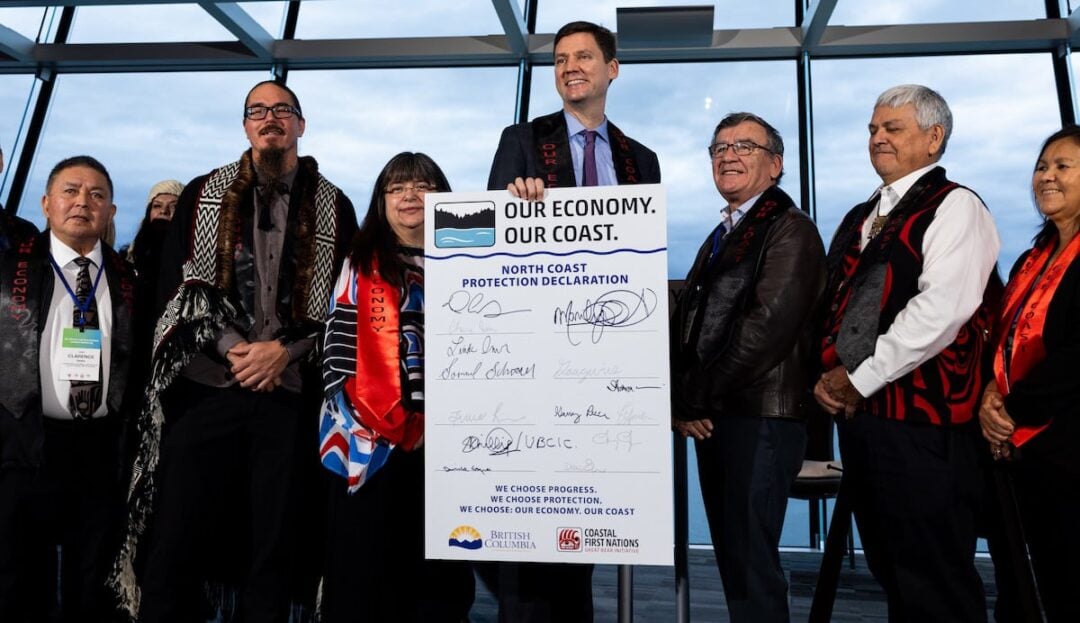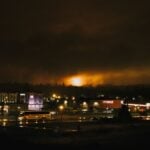By Rochelle Baker, Local Journalism Initiative, Canada’s National Observer
An American-owned cargo barge sitting dangerously low in the water near Bella Bella has reignited coastal First Nations’ fears about the dangers that oil tankers pose for the BC coast.
The Haíɫzaqv Nation’s marine emergency response team received reports early on Monday that heavily loaded Alaska Marine Lines barge being towed by the tug Malolo was taking on water in Fischer Channel near Bella Bella, said William Housty, director of the Heiltsuk Integrated Resource Management Department.
The tug and barge, which were transiting from Alaska to Washington, have taken shelter in a safer area near Matthew Island. While there are no immediate concerns about pollution and the barge hasn’t taken on more water, the marine response team is standing by, Housty said.
“Everybody’s pretty tight-lipped. We can’t get an answer from anybody.”
William Housty, Director of the Heiltsuk Integrated Resource Management Department
Though the nation has had contact with the Canadian Coast Guard, Transport Canada and the tug captain, the nation has no idea what’s in the more than 100 shipping containers stacked aboard the tilting barge — despite pushing for more information, he said.
“Everybody’s pretty tight-lipped. We can’t get an answer from anybody,” Housty said.
Knowing the containers’ contents would help the Haíɫzaqv prepare and respond to the incident if the cargo escapes before a replacement barge arrives Thursday, he said.
“We pretty much have to prepare [as] though it’s the worst case.”
Initial dives assessing the problem revealed the barge’s hull had significant punctures and was taking in water in two compartments, Housty said, noting divers confirmed one “hole was so large he could have swum right through it.”
Because the hull was “compromised in several places,” Housty assumes “it must have run aground somewhere. We don’t know where at this time.”
The Haíɫzaqv are still “reeling” from a devastating diesel spill after the tug Nathan E. Stewart ran aground in Heiltsuk wasters in October 2016, Housty said.

The incident spilled more than 110,000 litres of diesel fuel into the Seaforth Channel, polluting one of the nation’s key seafood harvesting grounds and prompting a lawsuit against the province, federal government and the company responsible, US-based Kirby Corporation.
“If we don’t have the resources to deal with a smaller vessel like this, how are we ever going to respond to a supertanker full of bitumen?”
William Housty, Director of the Heiltsuk Integrated Resource Management Department
The diesel spill and the recent barge incident underscore the limits of Canada’s ability to respond to significant shipping disasters on BC’s rugged West Coast.
If the federal government lifts the decades-long oil tanker ban, the next accident could involve crude or bitumen, with long-lasting consequences that will be impossible to contain, Housty said.
“If we don’t have the resources to deal with a smaller vessel like this, how are we ever going to respond to a supertanker full of bitumen?” Housty asked.
“It’s not a matter of if something is going to happen — it’s when.”
“We are tired of learning about these discussions regarding our traditional territories in the press.”
Marilyn Slett, President of Coastal First Nations and Elected Chief Councillor of the Haíɫzaqv Nation
Numerous coastal First Nations and the BC government signed a declaration earlier this month demanding that the federal government reaffirm its commitment to the legislated oil tanker moratorium. However, Prime Minister Mark Carney is reportedly close to sealing a deal with Alberta Premier Danielle Smith for plans to build a new oil pipeline to the BC coast that would allow tankers to transit the north coast, according to The Globe and Mail.

Marilyn Slett, President of Coastal First Nations and elected Chief Councillor of the Haíɫzaqv Nation, expressed alarm about closed-door talks for a pipeline project that would negatively impact coastal First Nations but which didn’t include them.
“We are tired of learning about these discussions regarding our traditional territories in the press,” Slett said in a statement on Wednesday.
“It is time for them to live up to their commitments and set up a respectful table that includes Coastal First Nations and the province of BC.”
Marilyn Slett, President of Coastal First Nations and Elected Chief Councillor of the Haíɫzaqv Nation
Coastal nations have made multiple requests for nation-to-nation meetings with both the prime minister and Natural Resources Minister Tim Hodgson on the issues, Slett said.
“It is time for them to live up to their commitments and set up a respectful table that includes Coastal First Nations and the province of BC,” she said.
“This approach is only building mistrust, and Canada should commit to talking with us directly instead of deliberately sidestepping our communities.”
The Ministry of Defence, which now oversees the Coast Guard, did not respond to Canada National Observer’s questions about the possible health, safety or environmental risks the barge’s cargo pose before publication deadline — saying only that vessel owners are responsible for the cost of addressing incidents including hazard-related costs and remediation activities taken by the federal government.
A second tug and barge are enroute and expected to arrive Thursday to begin offloading the shipping containers, Housty said, and divers, welders, and crane operators are also being flown into the community to conduct repairs and oversee offloading.



